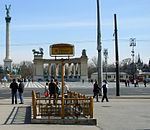Budapest Zoo and Botanical Garden

The Budapest Zoo & Botanical Garden (Hungarian: Fővárosi Állat- és Növénykert, lit. 'Metropolitan Zoo and Botanical Garden') is the oldest zoo in Hungary and one of the oldest in the world. It has 1,072 animal species and is located within the City Park of Budapest, in the centre of the city, unusually for a zoo. The zoo opened its doors on 9 August 1866. The park has 1–1.1 million visitors every year. The area is a nature reserve, and has some valuable art nouveau buildings designed by Kornél Neuschloss and Károly Kós. The most special animals that are present in the zoo are the Komodo dragon and since December 2011 the wombat. The zoo is located in the city centre and can be reached by Line 1 of the Budapest Metro. Official city card (Budapest Card) owners get a 25% discount for a single ticket into the zoo.
Excerpt from the Wikipedia article Budapest Zoo and Botanical Garden (License: CC BY-SA 3.0, Authors, Images).Budapest Zoo and Botanical Garden
Állatkerti körút, Budapest City Park
Geographical coordinates (GPS) Address External links Nearby Places Show on map
Geographical coordinates (GPS)
| Latitude | Longitude |
|---|---|
| N 47.518022222222 ° | E 19.077505555556 ° |
Address
Fővárosi Állat- és Növénykert
Állatkerti körút 6-16
1146 Budapest, City Park
Hungary
Open on Google Maps









